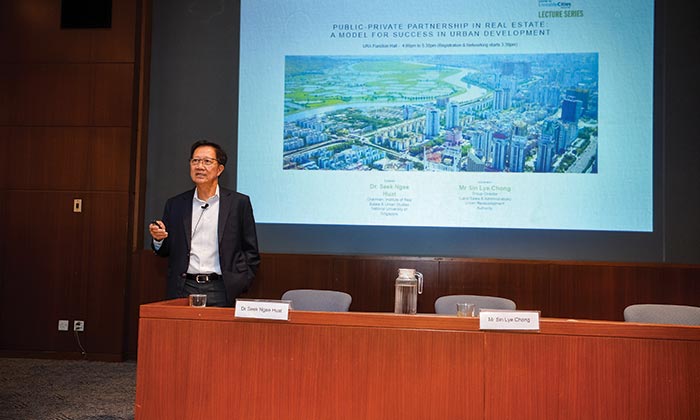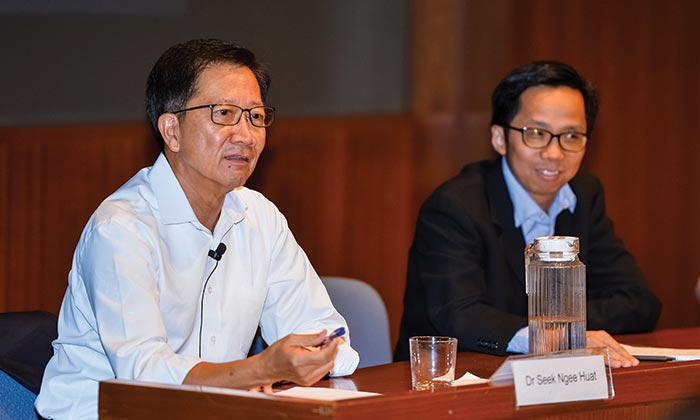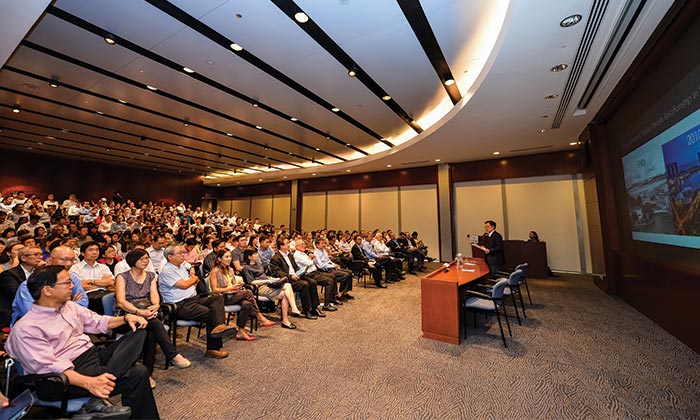Public-Private Partnership in Real Estate
 4 October 2018
4 October 2018
 4.00 pm – 5.30 pm. Registration from 3.30pm, seated by 4.00pm
4.00 pm – 5.30 pm. Registration from 3.30pm, seated by 4.00pm
 URA Function Hall, 5th Storey, The URA Centre, 45 Maxwell Road, Singapore 069118
URA Function Hall, 5th Storey, The URA Centre, 45 Maxwell Road, Singapore 069118
 2 BOA-SIA CPD pts, 1 SILA CPD pt
2 BOA-SIA CPD pts, 1 SILA CPD pt
Resources
Lecture Poster (PDF: 219KB)
Lecture Report (PDF: 385KB)
Lecture Slides (PDF: 6.5MB)
Lecture Transcript (PDF: 1.1MB)
Lecture Video & Photos
 The private sector played a significant role in the development of Shenzhen’s central business district and its river.
The private sector played a significant role in the development of Shenzhen’s central business district and its river.
Source: SSDPenguin, English Wikipedia Dr Seek makes a case for why the private sector should have a bigger say in the development of a city and the ingredients required for a successful partnership. Source: The Centre for Liveable Cities
Dr Seek makes a case for why the private sector should have a bigger say in the development of a city and the ingredients required for a successful partnership. Source: The Centre for Liveable Cities According to Dr Seek, several factors are important for PPP to work in real estate: market timing, planning, urban design and the alignment of public and private sector interests.
According to Dr Seek, several factors are important for PPP to work in real estate: market timing, planning, urban design and the alignment of public and private sector interests.
Source: The Centre for Liveable Cities The lecture attracted a vast range of audience keen to learn about the symbiotic relationship between the public and private sectors in real estate. Source:The Centre for Liveable Cities
The lecture attracted a vast range of audience keen to learn about the symbiotic relationship between the public and private sectors in real estate. Source:The Centre for Liveable Cities
Synopsis
Various models of Private-Public-Partnerships have driven urban development, both in Singapore and globally. In this lecture, Dr Seek Ngee Huat critically reviews reviewing different local and overseas PPP projects.
In particular, he will explore how the symbiotic relationship between the public and private sectors has contributed to Singapore’s urban transformation. Dr Seek will also discuss emerging PPP-related challenges and opportunities that Singapore may need to address.
Lecture Report
Greater private sector participation can spur more innovation
for the next stage of Singapore’s urban development.
With a bigger say in the city’s concept plans and development
uses, as well as more involvement in upstream decisionmaking, real estate developers can harness a global pool of
institutional capital and fresh ideas to transform Singapore,
says Dr Seek Ngee Huat.
Speaking at a CLC lecture in October, the chairman of the National University
of Singapore’s Institute of Real Estate Studies laid out a model for success in
urban development led by a rethinking of the public private partnership (PPP)
in Singapore. While the city’s development has been defined for decades by
the public sector — which is its largest land owner and housing developer —
Dr Seek said it is time for the private sector to play a bigger role.
“It is clear that the symbiotic relationship between the public and private
sectors is a key success factor in transforming Singapore from what was in
1965, a poor Third World city, to a world-class metropolis,” he said.
“But we’re in a different world from 20, 30 years ago… The public sector is so
good at what it does and so dominant that we may run the risk of stifling new
ideas and innovations from the private sector.”
Unlike in the past, private developers today are more sophisticated having
seen the world. They are better equipped to harness market forces and tap
market knowledge, as well as possess a greater capacity and willingness to
take risks in real estate development.
According to Dr Seek, several factors are important for PPP to work in real
estate. These include market timing, planning and urban design as well as the
alignment of public and private sector interests. For instance, the Singapore
government’s assurances then to limit new land supply in the vicinity of Suntec
City and Marina Bay Financial Centre was important in reducing uncertainties
for the developers of these two projects. However, he also noted that in the
case of Suntec City, the developer’s choice of selling its offices as strata title
units to quickly turn a profit may not have been aligned with the long-term
objective of anchoring Singapore as an international convention hub.
While the private sector is motivated by profits, it is not always about shortterm gains, added Dr Seek. Overseas developments, such as Canary Wharf
in London and Yu Tian Village in Shenzhen, show how the private sector can
successfully take the lead. The developer of Canary Wharf contributed to thebuilding of a subway line and station and pursued long-term strategies
that lasted for over 30 years. For Yu Tian Village, the developer took the
initiative to pursue a master lease with property owners as well as upgrade
lower-quality residences and create more common spaces. Such an “impact
investment” allowed the developer to reap modest returns while also
benefitting the community.
To aid the successful partnership between the public and the
private sector, Dr Seek suggested policy makers consider profit
sharing models, which is currently not used in Singapore.
These examples demonstrate the importance of picking the right partner,
says Dr Seek. “It’s pretty clear that we want partners to have strong
financial resources and shared long-term values.”
To aid the successful partnership between the public and the private
sector, Dr Seek suggested policy makers consider profit sharing models,
which is currently not used in Singapore. He gave the example of the
Queen Victoria building in Sydney, a former run-down site that was
successfully restored into a shopping centre by a Malaysian developer.
This arrangement ensures the developer will get back its money and
investment, and beyond that, the revenue is split. The state also retains
ownership of the building.
“This ensures the developer does a good job in turning this thing around
and making it viable, and the government can keep an eye on the
development to make sure the revenue is generating the way it should
be,” he says. “If the two partners are sharing profit over a long period,
their interests are much better aligned.”
This report first appeared in the
Nov 2018 Better Cities newsletter.
About the Speakers
SPEAKER
Dr Seek Ngee Huat
Chairman,
Institute of Real Estate Studies,
National University of Singapore
Dr Seek Ngee Huat is Chairman of the Institute of Real Estate and Urban
Studies at the National University of Singapore (NUS), where he is also
Practice Professor of Real Estate. He is Chairman of GLP IM Holdings
Ltd and a board member of Brookfield Asset Management Inc., Canada
and the Centre for Liveable Cities. He is also a senior advisor to Frasers
Property Ltd and the Canadian Pension Plan Investment Board. He was
previously the Chairman of Global Logistic Properties Ltd, Chairman of
ULI Asia Pacific, President of GIC Real Estate Pte Ltd and board director
of GIC Private Limited. Before joining GIC, he was a Senior Partner at
Jones Lang Wootton in Sydney.
MODERATOR
Sin Lye Chong
Group Director (Land Sales & Administration)
Urban Redevelopment Authority
Mr Sin Lye Chong graduated with a First Class Honours in Economics.
He started his career as a Research Officer in URA, before doing a stint
with Physical Planning Group. He was also seconded to the Ministry
of Finance and Ministry of National Development. Mr Sin took on the
current appointment of Group Director (Land Sales & Administration
Group) in 2014. In this role, his main responsibilities are helping the
Singapore Government formulate property market policies to promote a
stable and sustainable property market, planning and implementing
the Government Land Sales programme, as well as managing URA’s car
park operations.